Books
Relationship Power Dynamics
When I was talking about relationship power dynamics a couple of weeks ago, the example that came to mind while I was mentally processing it was Pride and Prejudice. That whole book boils down to people who are trying to hold on to all their power, which is impossible if you want to start a relationship. There has to be some kind of vulnerability in order to connect with another person. You’ve eventually got to let them know you care. Of course, my brain wouldn’t let it go, since if it’s worth analyzing, it’s worth overanalyzing. So, here’s a look at the relationship power dynamics in Pride and Prejudice. Spoilers ahead, but the book is 200 years old.
To start with, Darcy has a lot of the power, in every sense. He’s got wealth and status and is considered a desirable marriage prospect. He can probably get just about any woman he wants. And yet he has to try to pile on the power by making it clear he’s not interested in any of the local women, especially not Lizzie. His offhand remark about her eyes is a hint that he might actually have some attraction to her, but he’s making an effort to avoid giving up any of the power that having any interest in her would take away.
Meanwhile, Lizzie is well aware that she has zero power here. She may be a member of the gentry, but her family is on the poor end of things, and she’s not going to inherit much. She has no wealth, and while she has status in this immediate community, she’d be a nobody elsewhere. Even in this community, her parents are embarrassing. Someone is going to have to like her a lot as a person or have some other motivation to want to marry her, and she’s acutely conscious of this. She doesn’t even feel like she’s a beauty. It’s her sister who’s considered the pretty one. Her way of clawing back some power in all this is to decide she has zero interest in Darcy, even if he is considered quite a catch. She loses that bit of power when he says he’s not interested in her.
So, she regains the sense of having the upper hand by first taking every opportunity to snub and insult him, then later by getting the dirt on him from Wickham. When she comes to believe based on Wickham’s stories that Darcy is a terrible person, Lizzie achieves the ultimate in relationship power: she no longer cares what he thinks or if he likes her. That helps her retain the upper hand when she runs into Darcy again. She can easily chat with him and tease him because she just doesn’t care.
 Meanwhile, Darcy has realized he’s in love with her, but his first effort at proposing is a total failure because he tries to do so without giving up any of his power. Yes, there’s the vulnerability of admitting he admires and loves her and wants to marry her, but he wraps it up in power displays by pointing out how unsuitable she is, how awful her family is, how she really has nothing going on for her. So, he may like her, but she’s lucky he does so because there’s not a lot there to like.
Meanwhile, Darcy has realized he’s in love with her, but his first effort at proposing is a total failure because he tries to do so without giving up any of his power. Yes, there’s the vulnerability of admitting he admires and loves her and wants to marry her, but he wraps it up in power displays by pointing out how unsuitable she is, how awful her family is, how she really has nothing going on for her. So, he may like her, but she’s lucky he does so because there’s not a lot there to like.
It’s only when he gets the shock of realizing that she doesn’t find his attitude all that appealing that he finally realizes he’s going to have to give a little if he wants her, and that’s when he writes the letter explaining all to her, making himself utterly vulnerable. He gives her a lot of power over him, since she could ruin his sister if she decided to spread the story publicly.
The next time they see each other, it’s with a very different dynamic. It’s interesting that the 1995 TV version adds even more vulnerability to him when he finds her at his home by having him in his wet shirt after his swim (in that era, a shirt was essentially considered underwear). That’s not in the book, so it’s Lizzie who’s feeling more powerless in having been caught touring his home, with his vulnerability coming from the fact that it’s the first time that he’s seen her since he poured all his thoughts out in the letter. When they come to each other from a place of vulnerability, without trying to cling to their power, they actually manage to connect.
Then he gives up the opportunity to gain power when he rescues her sister from being a shamed social outcast without getting credit for it, which would have made her obligated to him. He’s willing to not take power that he’s owed. She’s the one who finds out and then makes her “offering” of letting him know she knows. There’s give and take, and this is when they’re able to finally get together for good.
I think this is one reason for the enduring popularity of this story. It’s nice to see a story about people getting over themselves and being able to admit they were wrong, and the relationship power dynamics end up being pretty balanced. They both have to give and take, and you get the sense that this relationship is going to work.
